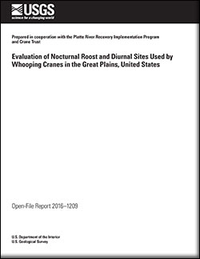Evaluation of nocturnal roost and diurnal sites used by whooping cranes in the Great Plains, United States
Links
- Document: Report (6.71 MB pdf)
- Download citation as: RIS | Dublin Core
Abstract
Endangered whooping cranes (Grus americana) of the Aransas-Wood Buffalo population migrate through the Great Plains twice each year. Although there is much interest in conservation and management for this species, information regarding characteristics of nocturnal roost sites used during migration has been limited and based largely on incidental observations. Using high-quality location data collected concurrently, we directed a companion field study designed to characterize sites used as roost or day-use sites to augment knowledge and assist the Platte River Recovery Implementation Program in identifying migration habitat for restoration, conservation, and management actions along the Platte River in central Nebraska. We collected data at 504 roost sites and 83 day-use sites used by marked whooping cranes in Texas, Oklahoma, Kansas, Nebraska, South Dakota, North Dakota, Minnesota, and Montana. Roost sites were located in emergent wetlands (50 percent), lacustrine wetlands (25 percent), rivers (20 percent), and dryland sites (5 percent). Most day-use sites were characterized as dryland sites (54 percent), with the balance in wetlands (45 percent) and rivers (1 percent). Habitat criteria thresholds initially derived by the Platte River Recovery Implementation Program to represent where 90 percent of whooping cranes used along the Platte River were different from those we measured over a larger section of the migration corridor. For most of the metrics, the Platte River Recovery Implementation Program’s initial habitat criteria thresholds would be considered more conservative than critical values estimated from our data; thus, whooping cranes were seemingly able to tolerate a wider range of these metrics than initially suspected. One exception was the metric distance to nearest disturbance feature, where our results suggest that whooping cranes may be less tolerant to nearby disturbances in a larger part of the migration corridor compared to the Platte River. We also determined correlations among some metrics and that using the criteria collectively lead to less than 50 percent of sites we measured being considered whooping crane habitat by the Platte River Recovery Implementation Program. A better understanding of how metrics function collectively may be useful for future efforts in defining habitat for migrating whooping cranes.
Suggested Citation
Pearse, A.T., Harner, M.J., Baasch, D.M., Wright, G.D., Caven, A.J., and Metzger, K.L., 2017, Evaluation of nocturnal roost and diurnal sites used by whooping cranes in the Great Plains, United States: U.S. Geological Survey Open-File Report 2016–1209, 29 p., https://doi.org/10.3133/ofr20161209.
ISSN: 2331-1258 (online)
Study Area
Table of Contents
- Introduction
- Study Area
- Methods
- Results
- Discussion
- Summary
- References Cited
- Appendixes 1–3
| Publication type | Report |
|---|---|
| Publication Subtype | USGS Numbered Series |
| Title | Evaluation of nocturnal roost and diurnal sites used by whooping cranes in the Great Plains, United States |
| Series title | Open-File Report |
| Series number | 2016-1209 |
| DOI | 10.3133/ofr20161209 |
| Publication Date | January 17, 2017 |
| Year Published | 2017 |
| Language | English |
| Publisher | U.S. Geological Survey |
| Publisher location | Reston, VA |
| Contributing office(s) | Northern Prairie Wildlife Research Center |
| Description | v, 29 p. |
| Country | United States |
| Online Only (Y/N) | Y |


